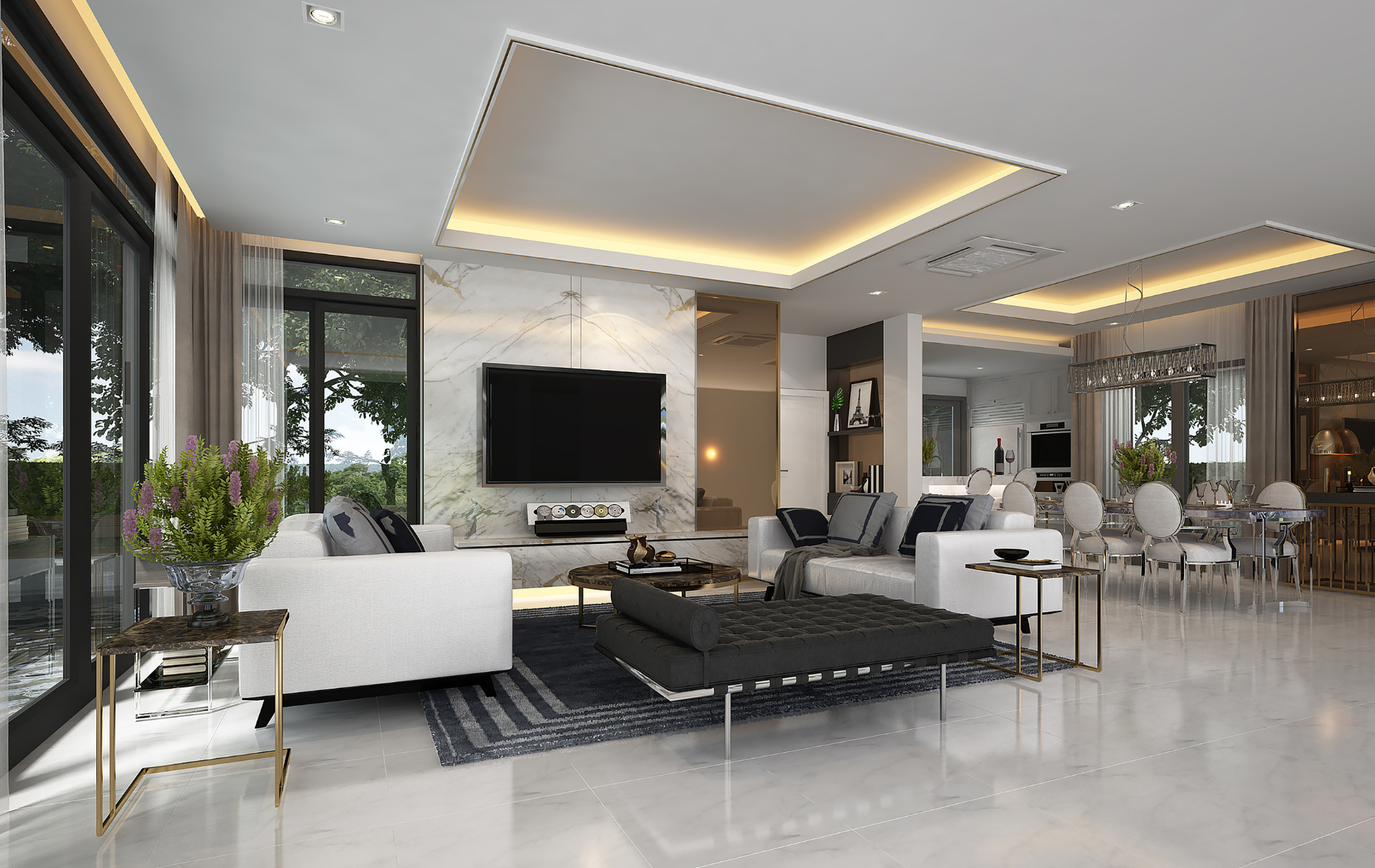How to Make a Small Living Room Feel Spacious
Learn expert strategies to maximize small living rooms. PNB Interior Design shares design tips for New England homes.

Small living rooms are a reality in many New England homes. From historic Massachusetts colonials with modest parlors to coastal Maine cottages designed for simplicity, compact living spaces often present both charm and challenge. While these rooms can feel cozy, without careful design they risk feeling cramped, dark, and cluttered.
The good news is that a small living room can feel far more spacious with the right strategies. At PNB Interior Design, Inc., we specialize in interior architectural design and space planning that maximizes square footage without sacrificing beauty. Below, we share our most effective techniques for making small living rooms feel open, comfortable, and stylish—strategies we use every day for our Massachusetts and Maine clients.
Step 1: Harness Natural and Artificial Light
Light transforms how we perceive space.
- Natural light: Keep windows as unobstructed as possible. Replace heavy drapes with sheer curtains or motorized shades that disappear into ceiling pockets. In coastal homes, we often recommend UV-filtering shades to protect interiors while maximizing brightness.
- Mirrors: Mirrors placed opposite windows bounce light and extend sightlines, making a room appear larger. Oversized mirrors framed in natural wood or metal feel intentional rather than utilitarian.
- Layered lighting: Instead of relying on one ceiling fixture, layer multiple sources: recessed cans, sconces, and table lamps. This removes dark corners and spreads illumination evenly.
Regional Example: In a Portland, Maine condo, we specified wall-mounted sconces rather than bulky floor lamps to free floor space and increase brightness.
Step 2: Select an Expansive Color Palette
Color has psychological power.
- Light neutrals: Whites, soft grays, and sandy beiges make walls recede.
- Monochromatic schemes: Keeping walls, trim, and ceilings within the same color family reduces visual boundaries.
- Cool tones: Pale blues and greens naturally feel airy and expansive, ideal for coastal homes.
Pro Tip: Use one consistent neutral for walls throughout the first floor of a small home to create seamless flow.
Step 3: Scale Furniture Correctly
Furniture is often the difference between a room that feels cramped and one that feels comfortable.
- Low-profile sofas: Streamlined silhouettes take less visual weight. Skip bulky armrests or oversized cushions.
- Exposed legs: Sofas and chairs with visible legs let light pass under, giving an airy effect.
- Multifunctional pieces: Storage ottomans, nesting tables, or benches maximize utility without adding clutter.
- Custom solutions: Tailored sofas or sectionals built to exact dimensions often outperform mass-market options.
Massachusetts Example: In a Worcester townhouse, we created a custom 72-inch sofa paired with nesting tables—perfectly scaled for the narrow living room without sacrificing comfort.
Step 4: Optimize Layout and Flow
Arranging furniture smartly is critical.
- Float furniture: Placing sofas a few inches off walls creates depth.
- Zoned areas: Rugs can define a seating area within open-concept layouts.
- Angled arrangements: Sometimes a diagonal placement expands sightlines better than rigid parallel layouts.
- Traffic flow: Always leave pathways open. Even 24–30 inches of clear passage makes a room feel larger.
Maine Example: In a coastal cottage, angling a loveseat toward the fireplace opened up circulation while keeping seating intimate.
Step 5: Maximize Vertical Space
When floor space is limited, build upward.
- Tall shelving: Extend built-ins to the ceiling, drawing the eye upward.
- High-hung drapery: Mount curtains just below the ceiling to make windows appear taller.
- Vertical art arrangements: Stacked frames or tall mirrors emphasize height.
This technique works particularly well in historic New England homes where ceilings are lower—by emphasizing vertical lines, we add perceived volume.
Step 6: Control Clutter with Built-Ins
Clutter shrinks a room instantly.
- Custom built-ins: Cabinets flanking a fireplace provide storage without consuming floor space.
- Hidden storage: Coffee tables with lift tops or ottomans with compartments hide blankets and remotes.
- Minimal accessories: Edit décor to a few impactful pieces. Larger accessories, used sparingly, appear more intentional than clusters of small trinkets.
Pro Tip: Apply the “one in, one out” rule—whenever a new decorative item enters, remove something else.
Step 7: Use Glass, Lucite, and Light Materials
Transparency keeps sightlines open.
- Glass tables: Provide surface area without blocking views of rugs or flooring.
- Lucite chairs: Nearly invisible, these add function without visual bulk.
- Open shelving: Styled minimally, it adds storage without heaviness.
We often combine transparent furniture with warm textiles like wool throws or jute rugs to balance the modern look with New England coziness.
Step 8: Anchor with the Right Rug
Rugs define zones and unify layouts.
- Large rugs: Contrary to instinct, a larger rug makes a room feel bigger by anchoring furniture.
- Neutral tones: Light colors expand space; patterns can work if they’re subtle and scaled appropriately.
- Natural textures: Sisal, jute, or flatweaves keep rooms grounded without overwhelming.
Regional Example: In a Cape Cod-style home, a 9x12 sisal rug unified the seating area, making the modest living room feel expansive.
Step 9: Highlight Architectural Character
Small rooms in New England often come with quirks—angled walls, built-in nooks, exposed beams. Instead of disguising them, integrate them.
- Historic homes: Paint uneven walls and trim in one color to minimize irregularities.
- Coastal cottages: Use beadboard or shiplap in light colors to emphasize vertical lines.
- Modern builds: Keep walls monochromatic and let furniture add texture.
By celebrating character rather than hiding it, you create a sense of intentional design.
Step 10: Invest in Custom Design
When every inch matters, customization pays dividends.
- Window seats: Provide storage and seating in one compact element.
- Built-in media centers: Eliminate the need for bulky entertainment units.
- Tailored furniture: Scaled precisely to your room’s proportions.
PNB Approach: We often design floor-to-ceiling cabinetry in small rooms, finished in the same paint as the walls. This makes the storage disappear while expanding functionality.
Regional Considerations: Massachusetts vs. Maine
Massachusetts
Homes often feature compact townhouses or historic colonials with smaller parlors. The goal is to preserve character while enhancing flow. We use warm neutrals, classic trim, and custom built-ins that respect the home’s history.
Maine
Coastal cottages emphasize views but may have modest interiors. We keep palettes light and natural—sand, driftwood, and pale blue—while integrating moisture-resistant finishes that withstand the coastal environment.
Both regions demand designs that are practical, durable, and timeless.
Common Mistakes to Avoid
- Overfurnishing: Too many pieces overwhelm space.
- Ignoring scale: Oversized sofas or rugs shrink a room visually.
- Dark, heavy drapery: Blocks light and makes ceilings appear lower.
- Too much décor: Clutter erases spaciousness.
- Neglecting lighting: Relying on one fixture creates shadows and reduces perceived volume.
FAQs
What colors make a small living room look larger?
Light neutrals like whites, creams, and sandy tones, or cool hues like pale blue, make walls recede.
Should I avoid dark colors completely?
No. Dark colors can be effective as accents—on an accent wall, cabinetry, or built-ins—when balanced with lighter surroundings.
Do sectional sofas work in small spaces?
Yes. A compact sectional hugging two walls often saves more space than multiple smaller chairs and sofas.
How can I increase storage in a small living room?
Use custom built-ins, storage ottomans, and concealed cabinetry. Built-in window seats are excellent for combining seating and storage.
What type of rug works best?
One large rug anchors a space better than multiple smaller ones. Choose light neutrals or subtle patterns.
Are mirrors effective in every small room?
Yes, when placed thoughtfully. Position them to reflect natural light or architectural details rather than blank walls.
What furniture styles should I avoid?
Bulky, overstuffed, and skirted furniture adds visual weight. Opt for pieces with slim profiles and exposed legs.
Can I hang art in a small living room?
Absolutely. Use fewer, larger pieces instead of many small frames to reduce visual clutter. Vertical arrangements can enhance height.
How do I make low ceilings feel taller?
Hang curtains higher, use vertical artwork, and paint walls and ceilings in the same or similar shades to blur boundaries.
Is custom furniture worth the investment?
Yes. In small spaces, custom sizing prevents wasted square footage and ensures proportions are balanced.
Conclusion
Learning
how to make a small living room feel spacious comes down to thoughtful design choices. By maximizing light, selecting scaled furniture, emphasizing vertical space, and reducing clutter, even the smallest New England rooms can feel open and welcoming. Whether in a Massachusetts colonial or a Maine coastal cottage, the right strategies transform cramped into comfortable.
At
PNB Interior Design, Inc., we bring licensed architectural and interior design expertise to every project. Our goal is to ensure your small living room is not only more spacious, but also more functional and reflective of your personal style.
Call to Action
Ready to make your small living room feel larger and more inviting? Contact
PNB Interior Design, Inc. today to schedule a consultation.
Contact Information
- Massachusetts Office: (508) 328-3231 – Northborough, MA
- Maine Office: (207) 374-7164 – Blue Hill, ME
- Email: pnb@pnbinc.com
- Website: PNB Interior Design – https://www.pnbincma.com
Internal Links:
- Space Planning –
https://www.pnbincma.com/space-planning
- Interior Design Services –
https://www.pnbincma.com/interior-design
External Links:
- Houzz Small Living Room Ideas –
https://www.houzz.com
- HGTV Small Living Spaces – https://www.hgtv.com


